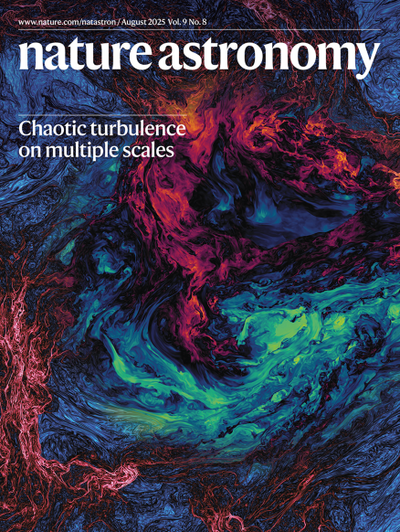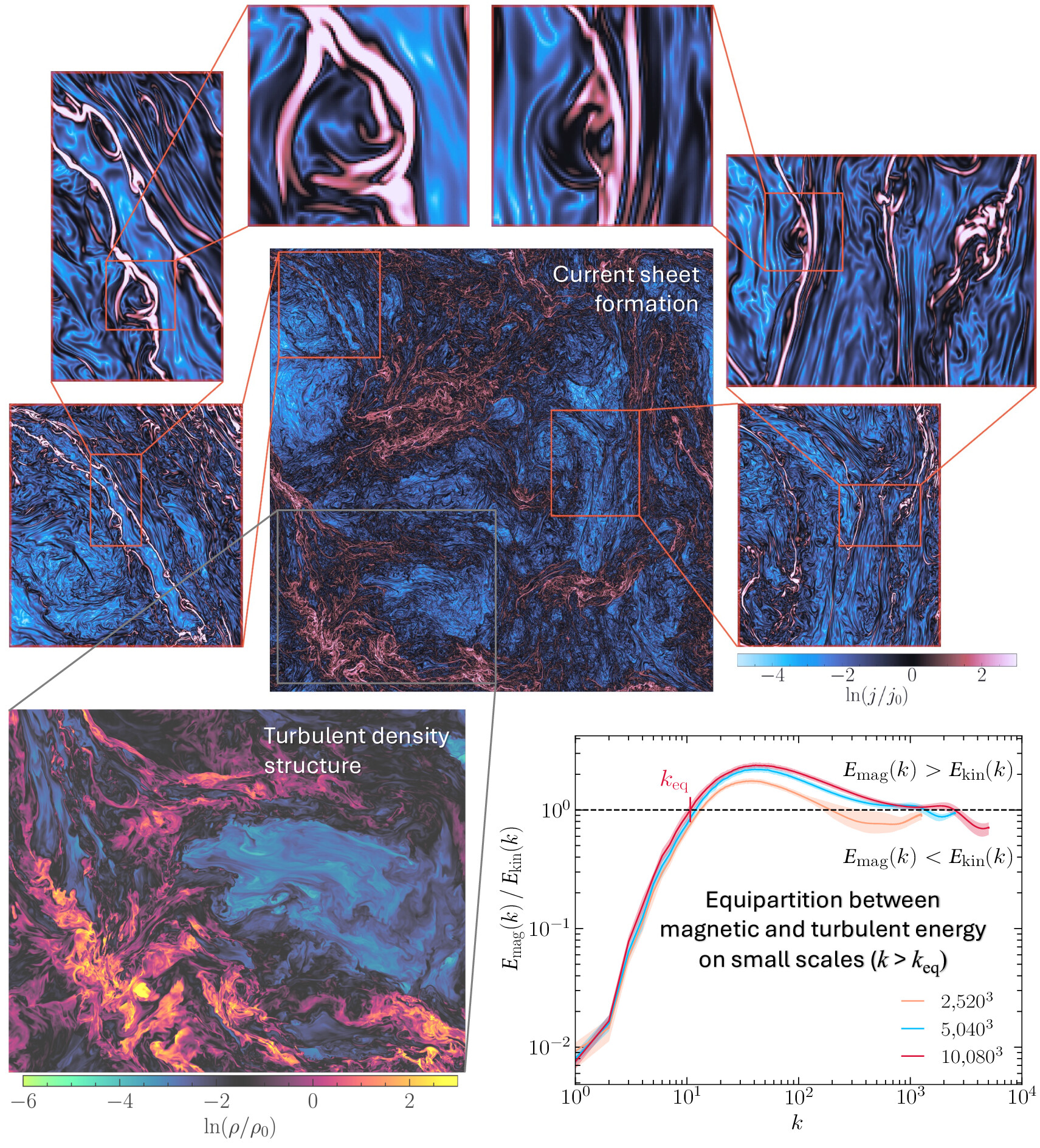
Contact Info
Australian National University
christoph.federrath@anu.edu.au
+61 (0)2 6125 0217
0000-0002-0706-2306
GitHub Bitbucket

Nature Astronomy, cover, August 2025.
https://phys.org/news/2025-05-astrophysicists-explore-galaxy-magnetic-turbulence.html
https://scienmag.com/unveiling-magnetized-turbulence-in-interstellar-space/
https://time.news/galaxy-turbulence-simulation-defies-expectations/
The interstellar medium (ISM) of our Galaxy is magnetized, compressible and turbulent, influencing many key ISM properties, such as star formation, cosmic-ray transport, and metal and phase mixing. Yet, basic statistics describing compressible, magnetized turbulence remain uncertain. Utilizing grid resolutions up to 10,080^3 cells, we simulated highly compressible, magnetized ISM-style turbulence with a magnetic field maintained by a small-scale dynamo. We measured two coexisting kinetic energy cascades, , in the turbulence, separating the plasma into scales that are non-locally interacting, supersonic and weakly magnetized (n=2.01+/-0.03~2) and locally interacting, subsonic and highly magnetized (n=1.465+/-0.002~3/2), where k is the wavenumber. We show that the 3/2 spectrum can be explained with scale-dependent kinetic energy fluxes and velocity-magnetic field alignment. On the highly magnetized modes, the magnetic energy spectrum forms a local cascade (n=1.798+/-0.001~9/5), deviating from any known ab initio theory. With a new generation of radio telescopes coming online, these results provide a means to directly test if the ISM in our Galaxy is maintained by the compressible turbulent motions from within it.

[ beattie_natastron.mp4, 76MB high-res mpeg 4 video ]
We acknowledge the useful discussions with D. Fielding, A. Chernoglazov and A. Beresnyak on the local anisotropy and alignment structure functions, and the more general discussions about this work with R. Bandyopadhyay, P. K.-S. Kempski, E. Quataert, A. Philippov, P. Mocz, B. Ripperda and C. Thompson. Funding: J.R.B. acknowledges financial support from the Australian National University (ANU), via the Deakin PhD and Dean's Higher Degree Research (theoretical physics) Scholarships and the Australian Government via the Australian Government Research Training Program Fee-Offset Scholarship and the Australian Capital Territory Government-funded Fulbright scholarship. J.R.B., C.F., R.S.K. and S.C. also acknowledge high-performance computing resources provided by the Leibniz Rechenzentrum and the Gauss Centre for Supercomputing (GCS) grants pr32lo, pr73fi and GCS large-scale project 10391. C.F. acknowledges funding by the Australian Research Council (Discovery Projects grants DP230102280 and DP250101526) and the Australia-Germany Joint Research Cooperation Scheme (UA-DAAD). C.F. also acknowledges high-performance computing resources provided by the Australian National Computational Infrastructure (grant ek9) and the Pawsey Supercomputing Centre (project pawsey0810) in the framework of the National Computational Merit Allocation Scheme and the ANU Merit Allocation Scheme. R.S.K. acknowledges support from the European Research Council (ERC) via the ERC Synergy Grant 'ECOGAL' (project ID 855130), from the German Excellence Strategy via the Heidelberg Cluster of Excellence (EXC 2181 - 390900948) 'STRUCTURES', and from the German Ministry for Economic Affairs and Climate Action in project 'MAINN' (funding ID 50OO2206). R.S.K. also expresses thanks for local computing resources provided by the Ministry of Science, Research and the Arts (MWK) of The Länd through bwHPC and the German Science Foundation (DFG) through grant INST 35/1134-1 FUGG and 35/1597-1 FUGG, and also for data storage at SDS@hd funded through grants INST 35/1314-1 FUGG and INST 35/1503-1 FUGG. J.R.B. and A.B. also acknowledge the support from NSF Award 2206756.